Novel Para-Aminobenzoic Acid Analogs and Their Potential Therapeutic Applications
Abstract
:1. Introduction
1.1. Chemistry of Para-Amino Benzoic Acid
1.2. p-Aminobenzoic Acid as a Biological Scaffold
2. Derivatization of p-Aminobenzoic Acids
2.1. Synthesis of Anti-Cholinesterase Agents
2.2. Anti-Cholinesterases Activity
3. Synthesis of Antimicrobial Agents
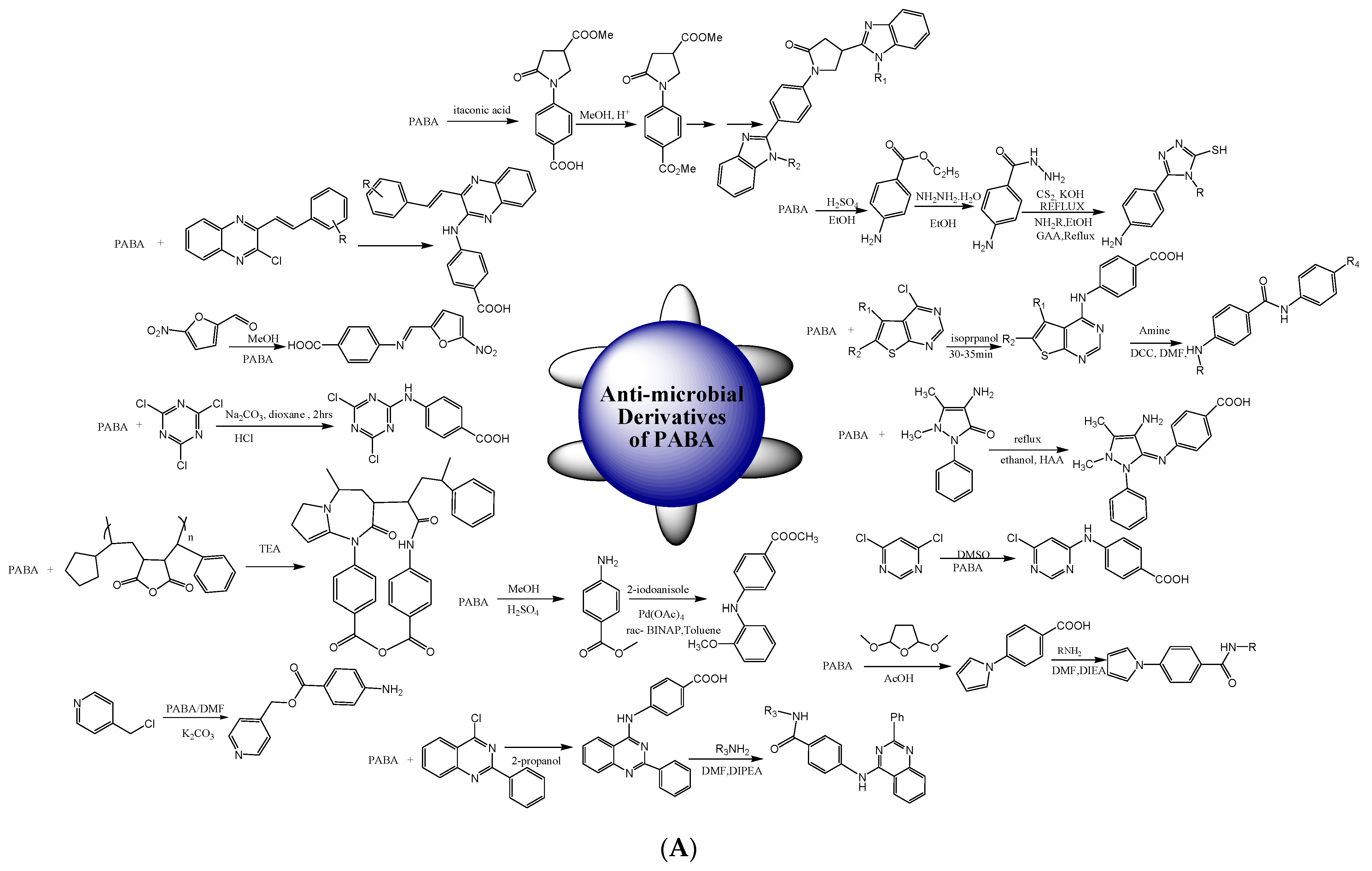
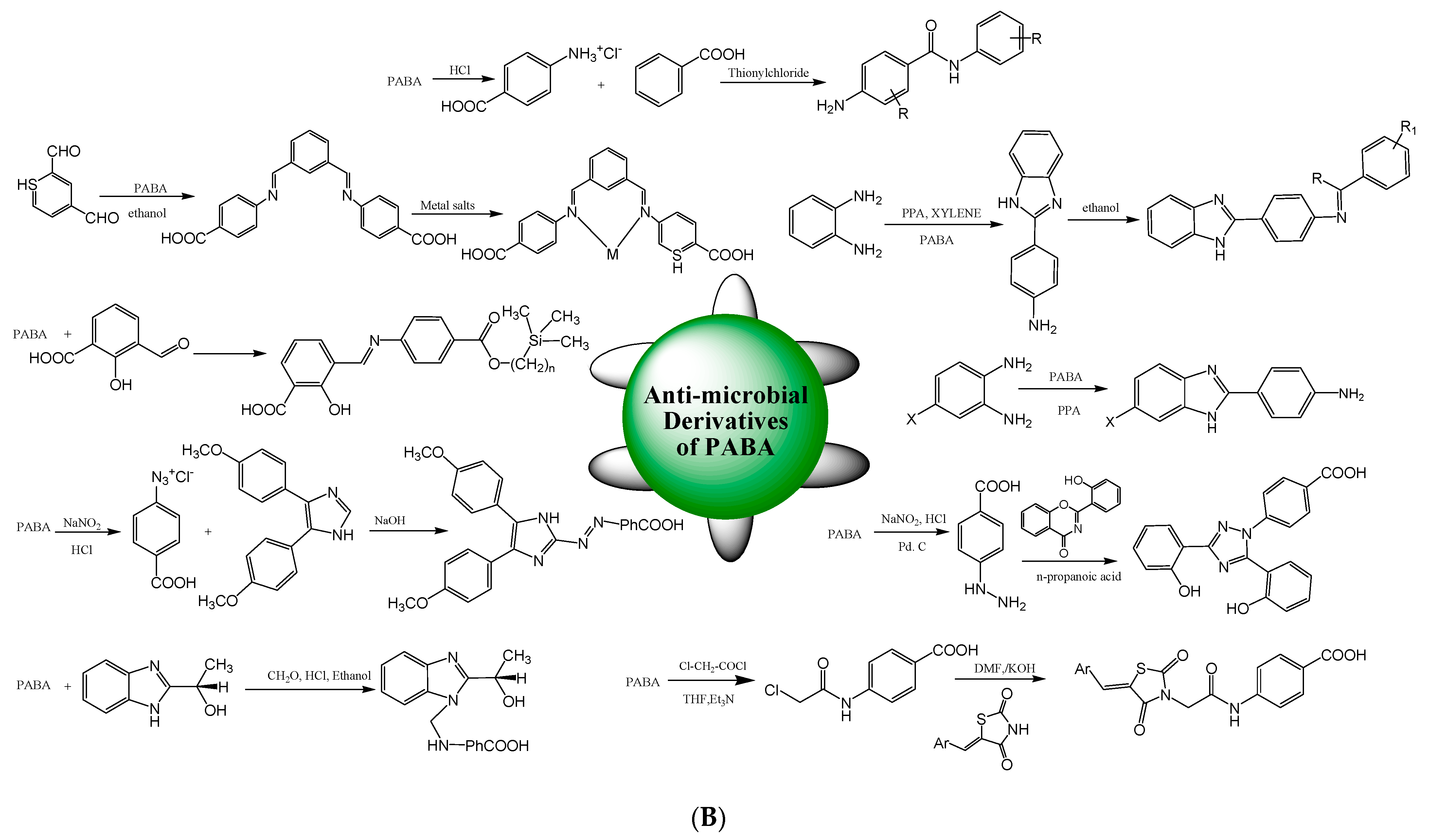
Antimicrobial Activity
4. Synthesis of Anticancer Agents
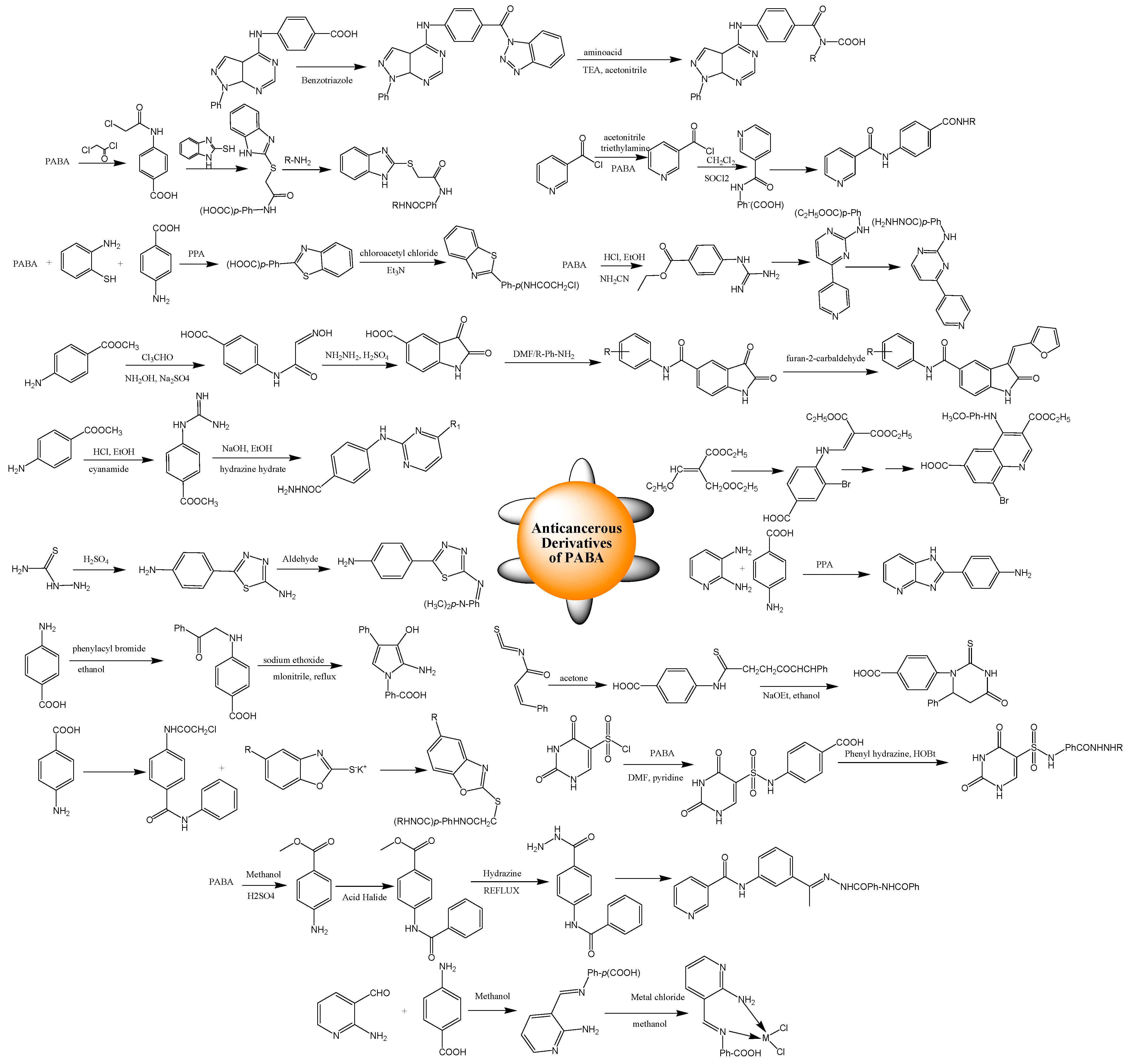
Anticancer Activity
5. Synthesis of Anti-Inflammatory Agents
Anti-Inflammatory Activities
6. Synthesis of Antiviral Agents
7. Future Perspectives and Challenges
8. Conclusions
Funding
Informed Consent Statement
Data Availability Statement
Conflicts of Interest
References
- Chen, L.; Wang, Z.; Qiu, T.; Sun, R.; Zhao, Z.; Tian, L.; Liu, X. Synthesis, structural characterization, and properties of triorganotin complexes of Schiff base derived from 3-aminobenzoic acid and salicylaldehyde or 2,4-pentanedione. Appl. Organomet. Chem. 2020, 34, e5790. [Google Scholar] [CrossRef]
- Al-Saffar, R.S.; Zakaria, S.A.; Othman, N.S. Spectrophotometric Determination of p-aminobenzoic acid via Diazotization and Coupling reaction. Res. J. Pharm. Technol. 2021, 14, 5313–5318. [Google Scholar] [CrossRef]
- Bobrovs, R.; Drunka, L.; Auzins, A.A.; Jaudzems, K.; Salvalaglio, M. Polymorph-selective role of hydrogen bonding and π–π stacking in p-aminobenzoic acid solutions. Cryst. Growth Des. 2020, 21, 436–448. [Google Scholar] [CrossRef]
- Meir, Z.; Osherov, N. Vitamin biosynthesis as an antifungal target. J. Fungi 2018, 4, 72. [Google Scholar] [CrossRef]
- DiNardo, J.C.; Downs, C.A. Dermatological and environmental toxicological impact of the sunscreen ingredient oxybenzone/benzophenone-3. J. Cosmet. Dermatol. 2018, 17, 15–19. [Google Scholar] [CrossRef]
- Al-Rubaie, A.Z.; Al-Jadaan, S.A.S.; Al-Wahed, A.T.A.; Raadah, I.A. Synthesis, characterization and biological studies of some new organometallic compounds containing mercury, selenium and tellurium based on p-aminobenzoic acid. J. Phys. Conf. Ser. 2021, 2063, 012003. [Google Scholar] [CrossRef]
- Cismesia, A.P.; Nicholls, G.R.; Polfer, N.C. Amine vs. carboxylic acid protonation in ortho-, meta-, and para-aminobenzoic acid: An IRMPD spectroscopy study. J. Mol. Spectrosc. 2017, 332, 79–85. [Google Scholar] [CrossRef]
- Bousis, S.; Setyawati, I.; Diamanti, E.; Slotboom, D.J.; Hirsch, A.K.H. Energy-coupling factor transporters as novel antimicrobial targets. Adv. Ther. 2019, 2, 1800066. [Google Scholar] [CrossRef]
- Garrett, G.S.; Bailey, L.B. A public health approach for preventing neural tube defects: Folic acid fortification and beyond. Ann. N. Y. Acad. Sci. 2018, 1414, 47–58. [Google Scholar] [CrossRef]
- Andlid, T.A.; D’Aimmo, M.R.; Jastrebova, J. Folate and bifidobacteria. In The Bifidobacteria and Related Organisms; Elsevier: Amsterdam, The Netherlands, 2018; pp. 195–212. [Google Scholar]
- Nisa, Z.U.; Akhtar, T. Para-aminobenzoic acid-A substrate of immense significance. Mini-Rev. Org. Chem. 2020, 17, 686–700. [Google Scholar] [CrossRef]
- Nichols, B.L.; Chen, J.; Mischnick, P.; Edgar, K.J. Selective oxidation of 2-hydroxypropyl ethers of cellulose and dextran: Simple and efficient introduction of versatile ketone groups to polysaccharides. Biomacromolecules 2020, 21, 4835–4849. [Google Scholar] [CrossRef] [PubMed]
- Ehzari, H.; Amiri, M.; Safari, M.; Samimi, M. Zn-based metal-organic frameworks and p-aminobenzoic acid for electrochemical sensing of copper ions in milk and milk powder samples. Int. J. Environ. Anal. Chem. 2022, 102, 4364–4377. [Google Scholar] [CrossRef]
- Horozić, E.; Ademović, Z.; Suljagić, J.; Cipurković, A.; Roša, E.; Sejfić, A.; Husejnagić, D.; Hodžić, S. Synthesis, spectral characterization, antibacterial and antifungal activity of copper (II)-pABA Complex. Technol. Acta Sci. Prof. J. Chem. Technol. 2019, 12, 27–30. [Google Scholar]
- Cruz-Cabeza, A.J.; Davey, R.J.; Sachithananthan, S.S.; Smith, R.; Tang, S.K.; Vetter, T.; Xiao, Y. Aromatic stacking—A key step in nucleation. Chem. Commun. 2017, 53, 7905–7908. [Google Scholar] [CrossRef] [PubMed]
- Kalembkiewicz, J.; Kosińska, M.; Zapała, L. Complexes of aminobenzoic acids: A comprehensive review concerning synthesis, physical chemistry, structure and application. Coord. Chem. Rev. 2017, 348, 25–53. [Google Scholar] [CrossRef]
- Opalko, A.I.; Weisfeld, L.I.; Bekuzarova, S.A.; Burakov, A.E. Tolerance improvement of indoor plants. In Temperate Horticulture for Sustainable Development and Environment; Apple Academic Press: Palm Bay, FL, USA, 2018; pp. 153–184. [Google Scholar]
- Castaño-Cerezo, S.; Fournié, M.; Urban, P.; Faulon, J.L.; Truan, G. Development of a biosensor for detection of benzoic acid derivatives in Saccharomyces cerevisiae. Front. Bioeng. Biotechnol. 2020, 7, 372. [Google Scholar] [CrossRef]
- Abdelgawad, M.A.; Hayallah, A.M.; Bukhari, S.N.A.; Musa, A.; Elmowafy, M.; Abdel-Rahman, H.M.; Abd El-Gaber, M.K. Design, Synthesis, Molecular Modeling, and Anticancer Evaluation of New VEGFR-2 Inhibitors Based on the Indolin-2-One Scaffold. Pharmaceuticals 2022, 15, 1416. [Google Scholar] [CrossRef]
- Maniati, M.S.; Maniati, M.; Yousefi, T.; Ahmadi-Ahangar, A.; Tehrani, S.S. New insights into the role of microRNAs and long noncoding RNAs in most common neurodegenerative diseases. J. Cell. Biochem. 2019, 120, 8908–8918. [Google Scholar] [CrossRef]
- Grochowska, K.; Przeliorz, A. The effect of the ketogenic diet on the therapy of neurodegenerative diseases and its impact on improving cognitive functions. Dement. Geriatr. Cogn. Disord. Extra 2022, 12, 100–106. [Google Scholar] [CrossRef]
- Breijyeh, Z.; Karaman, R. Comprehensive review on Alzheimer’s disease: Causes and treatment. Molecules 2020, 25, 5789. [Google Scholar] [CrossRef]
- El Khatabi, K.; Aanouz, I.; El-Mernissi, R.; Khaldan, A.; Ajana, M.A.; Bouachrine, M.; Lakhlifi, T. 3D-QSAR and molecular docking studies of p-aminobenzoic acid derivatives to explore the features requirements of Alzheimer inhibitors. Orbital Electron. J. Chem. 2020, 10, 172–181. [Google Scholar] [CrossRef]
- Zhao, J.; Zhang, B.; Mao, Q.; Ping, K.; Zhang, P.; Lin, F.; Liu, D.; Feng, Y.; Sun, M.; Zhang, Y.; et al. Discovery of a Colon-Targeted Azo Prodrug of Tofacitinib through the Establishment of Colon-Specific Delivery Systems Constructed by 5-ASA–PABA–MAC and 5-ASA–PABA–Diamine for the Treatment of Ulcerative Colitis. J. Med. Chem. 2022, 65, 4926–4948. [Google Scholar] [CrossRef] [PubMed]
- Shrivastava, S.K.; Sinha, S.K.; Srivastava, P.; Tripathi, P.N.; Sharma, P.; Tripathi, M.K.; Tripathi, A.; Choubey, P.K.; Waiker, D.K.; Aggarwal, L.M.; et al. Design and development of novel p-aminobenzoic acid derivatives as potential cholinesterase inhibitors for the treatment of Alzheimer’s disease. Bioorgan. Chem. 2019, 82, 211–223. [Google Scholar] [CrossRef]
- Shrivastava, S.K.; Srivastava, P.; Upendra, T.; Tripathi, P.N.; Sinha, S.K. Design, synthesis and evaluation of some N-methylenebenzenamine derivatives as selective acetylcholinesterase (AChE) inhibitor and antioxidant to enhance learning and memory. Bioorgan. Med. Chem. 2017, 25, 1471–1480. [Google Scholar] [CrossRef]
- Tang, X.-M.; Hu, W.; Fan, L.; Wang, H.; Tang, M.-H.; Yang, D.-C. Synthesis and evaluation of novel peptidomimetics bearing p-aminobenzoic acid moiety as potential antidiabetic agents. Future Med. Chem. 2020, 12, 991–1013. [Google Scholar] [CrossRef] [PubMed]
- Van Duijkeren, E.; Schwarz, C.; Bouchard, D.; Catry, B.; Pomba, C.; Baptiste, K.E.A.; Moreno, M.; Rantala, M.; Ružauskas, M.; Sanders, P.; et al. The use of aminoglycosides in animals within the EU: Development of resistance in animals and possible impact on human and animal health: A review. J. Antimicrob. Chemother. 2019, 74, 2480–2496. [Google Scholar] [CrossRef] [PubMed]
- Morris, S.; Cerceo, E. Trends, epidemiology, and management of multi-drug resistant gram-negative bacterial infections in the hospitalized setting. Antibiotics 2020, 9, 196. [Google Scholar] [CrossRef]
- Sapijanskaitė-Banevič, B.; Palskys, V.; Vaickelionienė, R.; Šiugždaitė, J.; Kavaliauskas, P.; Grybaitė, B.; Mickevičius, V. Synthesis and antibacterial activity of new azole, diazole and triazole derivatives based on p-aminobenzoic acid. Molecules 2021, 26, 2597. [Google Scholar] [CrossRef]
- Krátký, M.; Konečná, K.; Janoušek, J.; Brablíková, M.; Janďourek, O.; Trejtnar, F.; Stolaříková, J.; Vinšová, J. 4-Aminobenzoic acid derivatives: Converting folate precursor to antimicrobial and cytotoxic agents. Biomolecules 2019, 10, 9. [Google Scholar] [CrossRef]
- Afifi, A.M.; Saad, A.M.; Al-Husseini, M.J.; Elmehrath, A.O.; Northfelt, D.W.; Sonbol, M.B. Causes of death after breast cancer diagnosis: A US population-based analysis. Cancer 2020, 126, 1559–1567. [Google Scholar] [CrossRef]
- Ghanem, N.M.; Farouk, F.; George, R.F.; Abbas, S.E.; El-Badry, O.M. Design and synthesis of novel imidazo [4,5-b] pyridine based compounds as potent anticancer agents with CDK9 inhibitory activity. Bioorgan. Chem. 2018, 80, 565–576. [Google Scholar] [CrossRef]
- Salem, I.M.; Mostafa, S.M.; Salama, I.; El-Sabbagh, O.I.; Hegazy, W.A.; Ibrahim, T.S. Design, synthesis and antitumor evaluation of novel pyrazolo [3, 4-d] pyrimidines incorporating different amino acid conjugates as potential DHFR inhibitors. J. Enzym. Inhib. Med. Chem. 2023, 38, 203–215. [Google Scholar] [CrossRef]
- Abuelizz, H.A.; Awad, H.M.; Marzouk, M.; Nasr, F.A.; Bakheit, A.H.; Naglah, A.M.; Al-Shakliah, N.S.; Al-Salahi, R. Exploiting the 4-Hydrazinobenzoic acid moiety for the development of anticancer agents: Synthesis and biological profile. Bioorgan. Chem. 2020, 102, 104098. [Google Scholar] [CrossRef]
- Khalilinia, E.; Ebrahimi, A. π-Stacking effects on acid capacity of p-aminobenzoic acid. Struct. Chem. 2020, 31, 1707–1716. [Google Scholar] [CrossRef]
- Adhikari, N.; Kashyap, A.; Shakya, A.; Ghosh, S.K.; Bhattacharyya, D.R.; Bhat, H.R.; Singh, U.P. Microwave assisted synthesis, docking and antimalarial evaluation of hybrid PABA-substituted 1, 3, 5-triazine derivatives. J. Heterocycl. Chem. 2020, 57, 2389–2399. [Google Scholar] [CrossRef]
- Patel, H.M.; Bhardwaj, V.; Sharma, P.; Noolvi, M.N.; Lohan, S.; Bansal, S.; Sharma, A. Quinoxaline-PABA bipartite hybrid derivatization approach: Design and search for antimicrobial agents. J. Mol. Struct. 2019, 1184, 562–568. [Google Scholar] [CrossRef]
- Han, M.I.; İnce, U.; Gündüz, M.G.; Coşkun, G.P.; Birgül, K.; Doğan, D.; Küçükgüzel, G. Synthesis, antimicrobial evaluation and molecular modeling studies of novel thiosemicarbazides/semicarbazides derived from p-aminobenzoic acid. J. Mol. Struct. 2022, 1261, 132907. [Google Scholar]
- Hameed, A.D.; Al-Fatlawi, A.A. Synthesis and Biological Activity of New Sulfonamide Derivatives. Int. J. Drug Deliv. Technol. 2021, 11, 1394–1398. [Google Scholar]
- Zafar, S.R.W.; Hassan, A.U.; Sumrra, S.H. Importance of Coordination Chemistry and Role of Sulfonamide Derived Compounds in Biological Activity—A Review. South. J. Res. 2022, 1, 53–69. [Google Scholar]
- Rupar, J.S.; Dobričić, V.D.; Aleksić, M.M.; Brborić, J.S.; Čudina, O.A. A review of published data on acridine derivatives with different biological activities. Kragujev. J. Sci. 2018, 40, 83–101. [Google Scholar] [CrossRef]
- Mansour, N.I.; El-Sayed, S.M.; El-Gohary, N.S.; Abdel-Aziz, N.I.; El-Subbagh, H.I.; Ghaly, M.A. New phthalimide-based derivatives as EGFR-TK inhibitors: Synthesis, biological evaluation, and molecular modeling study. Bioorgan. Chem. 2022, 127, 105966. [Google Scholar] [CrossRef] [PubMed]
- Loredo-Calderón, E.L.; Velázquez-Martínez, C.A.; Ramírez-Cabrera, M.A.; Hernández-Fernández, E.; Rivas-Galindo, V.M.; Espinoza, E.A.; López-Cortina, S.T. Synthesis of novel α-aminophosphonates under microwave irradiation, biological evaluation as antiproliferative agents and apoptosis inducers. Med. Chem. Res. 2019, 28, 2067–2078. [Google Scholar] [CrossRef]
- Hamoud, M.M.S.; Pulya, S.; Osman, N.A.; Bobde, Y.; Hassan, A.E.A.; Abdel-Fattah, H.A.; Ghosh, B.; Ghanim, A.M. Design, synthesis, and biological evaluation of novel nicotinamide derivatives as potential histone deacetylase-3 inhibitors. New J. Chem. 2020, 44, 9671–9683. [Google Scholar] [CrossRef]
- Hamid, S.J.; Salih, T. Design, synthesis, and anti-inflammatory activity of some coumarin Schiff base derivatives: In silico and in vitro study. Drug Des. Dev. Ther. 2022, 16, 2275–2288. [Google Scholar] [CrossRef]
- Li, H.; Mirzayans, P.M.; Butler, M.S.; Lacey, A.E.; Vuong, D.; Chen, R.; Kalaitzis, J.A.; Moggach, S.A.; Lacey, E.; Piggott, A.M.; et al. Discovery of brevijanazines from Aspergillus brevijanus reveals the molecular basis for p-nitrobenzoic acid in fungi. Chem. Commun. 2022, 58, 6296–6299. [Google Scholar] [CrossRef]
- Mustafa, M.; Mostafa, Y.A. A facile synthesis, drug-likeness, and in silico molecular docking of certain new azidosulfonamide–chalcones and their in vitro antimicrobial activity. Monatshefte Für Chem.-Chem. Mon. 2020, 151, 417–427. [Google Scholar] [CrossRef]
- Kamar, A.K.D.b.A.; Yin, L.J.; Liang, C.T.; Fung, G.T.; Avupati, V.R. Rhodanine scaffold: A review of antidiabetic potential and structure-activity relationships (SAR). Med. Drug Discov. 2022, 15, 100131. [Google Scholar] [CrossRef]
- Kalaycı, M.; Türkeş, C.; Arslan, M.; Demir, Y. Novel benzoic acid derivatives: Synthesis and biological evaluation as multitarget acetylcholinesterase and carbonic anhydrase inhibitors. Arch. Der Pharm. 2021, 354, 2000282. [Google Scholar] [CrossRef]
- Singh, S.K.; Sinha, S.K.; Shirsat, M.K. Design, synthesis and evaluation of some new 4-aminobenzoic acid derivatives as potential cognition enhancer. World J. Pharm. Pharm. Sci. 2017, 6, 959–975. [Google Scholar]
- Iftikhar, K.; Murtaza, S.H.A.H.Z.A.D.; Kousar, N.; Abbas, A.; Tahir, M.N. Aminobenzoic acid derivatives as antioxidants and cholinesterase inhibitors; synthesis, biological evaluation and molecular docking studies. Acta Polon. Pharma-Drug Res. 2018, 75, 385–396. [Google Scholar]
- Almaz, Z.; Oztekin, A.; Tan, A.; Ozdemir, H. Biological evaluation and molecular docking studies of 4-aminobenzohydrazide derivatives as cholinesterase inhibitors. J. Mol. Struct. 2021, 1244, 130918. [Google Scholar] [CrossRef]
- Özil, M.; Balaydın, H.T.; Şentürk, M. Synthesis of 5-methyl-2,4-dihydro-3H-1, 2,4-triazole-3-one’s aryl Schiff base derivatives and investigation of carbonic anhydrase and cholinesterase (AChE, BuChE) inhibitory properties. Bioorgan. Chem. 2019, 86, 705–713. [Google Scholar] [CrossRef] [PubMed]
- Padrtova, T.; Marvanova, P.; Odehnalova, K.; Kubinova, R.; Parravicini, O.; Garro, A.; Enriz, R.D.; Humpa, O.; Oravec, M.; Mokry, P. Synthesis, analysis, cholinesterase-inhibiting activity and molecular modelling studies of 3-(dialkylamino)-2-hydroxypropyl 4-[(alkoxy-carbonyl) amino] benzoates and their quaternary ammonium salts. Molecules 2017, 22, 2048. [Google Scholar] [CrossRef]
- Abo-Ashour, M.F.; Almahli, H.; Bonardi, A.; Khalil, A.; Al-Warhi, T.; Al-Rashood, S.T.; Abdel-Aziz, H.A.; Nocentini, A.; Supuran, C.T.; Eldehna, W.M. Enaminone-based carboxylic acids as novel non-classical carbonic anhydrases inhibitors: Design, synthesis and in vitro biological assessment. J. Enzym. Inhib. Med. Chem. 2022, 37, 2256–2264. [Google Scholar] [CrossRef] [PubMed]
- Rajurkar, V.G.; Shirsath, S.M. Green synthesis and evaluation of 5-(4-aminophenyl)-4-aryl-4H-1,2,4-triazole-3-thiol derivatives. Iran. J. Pharm. Sci. 2017, 13, 37–50. [Google Scholar]
- Gill, R.K.; Singh, H.; Raj, T.; Sharma, A.; Singh, G.; Bariwal, J. 4-Substituted thieno [2, 3-d] pyrimidines as potent antibacterial agents: Rational design, microwave-assisted synthesis, biological evaluation and molecular docking studies. Chem. Biol. Drug Des. 2017, 90, 1115–1121. [Google Scholar] [CrossRef]
- Al-Zaydi, K.M.; Khalil, H.H.; El-Faham, A.; Khattab, S.N. Synthesis, characterization and evaluation of 1, 3, 5-triazine aminobenzoic acid derivatives for their antimicrobial activity. Chem. Cent. J. 2017, 11, 1–12. [Google Scholar] [CrossRef]
- Matshwele, J.T.; Jongman, M.; Koobotse, M.O.; Mazimba, O.; Mapolelo, D.; Nkwe, D.O.; Nareetsile, F.; Odisitse, S. Synthesis, characterization of nitro or amino substituted pyridyl ligands bridged by an ester or ether bond, and their antibacterial assessment against drug resistant bacteria. Results Chem. 2022, 4, 100401. [Google Scholar] [CrossRef]
- Shaikh, M.S.; Chandrasekaran, B.; Palkar, M.B.; Kanhed, A.M.; Kajee, A.; Mlisana, K.P.; Singh, P.; Ghai, M.; Mahlalela, M.C.; Karpoormath, R.V. Synthesis and biological evaluation of novel carbazole hybrids as promising antimicrobial agents. Chem. Biodivers. 2020, 17, e1900550. [Google Scholar] [CrossRef]
- Ajithkumar, M.P.; Yashoda, M.P.; Prasannakumar, S.; Sruth, T.V.; Sameer Kumar, V.B. Poly (N-vinyl-2-pyrrolidone-maleic anhydride-styrene) grafted terpolymer: Synthesis, characterization, and bactericidal property evaluation against E. coli and S. epidermidis. J. Macromol. Sci. Part A 2017, 54, 480–488. [Google Scholar] [CrossRef]
- Al-Shemary, R.K.R.; Karem, L.K.A.; Ghanim, F.H. Diagnosis, Structure, and in the Vitro Antimicrobial and Antifungal Evaluation of Some Amino Benzoic Acids-Derived Ligand Schiff Base and Their Mixed Complexes with Cu (II), Hg (II), Mn (II), Ni (II) and Co (II). Orient. J. Chem. 2018, 34, 1105. [Google Scholar] [CrossRef]
- Homzová, K.; Győryová, K.; Hudecová, D.; Koman, M.; Melník, M.; Kovářová, J. Synthesis, thermal, spectral, and biological properties of zinc (II) 4-aminobenzoate complexes. J. Therm. Anal. Calorim. 2017, 129, 1065–1082. [Google Scholar] [CrossRef]
- Malasala, S.; Ahmad, N.; Gour, J.; Shukla, M.; Kaul, G.; Akhir, A.; Gatadi, S.; Madhavi, Y.; Chopra, S.; Nanduri, S. Synthesis, biological evaluation and molecular modelling insights of 2-arylquinazoline benzamide derivatives as anti-tubercular agents. J. Mol. Struct. 2020, 1218, 128493. [Google Scholar] [CrossRef]
- Joshi, S.D.; Dixit, S.R.; Basha, J.; Kulkarni, V.; Aminabhavi, T.M.; Nadagouda, M.N.; Lherbet, C. Pharmacophore mapping, molecular docking, chemical synthesis of some novel pyrrolyl benzamide derivatives and evaluation of their inhibitory activity against enoyl-ACP reductase (InhA) and Mycobacterium tuberculosis. Bioorgan. Chem. 2018, 81, 440–453. [Google Scholar] [CrossRef] [PubMed]
- Choudhury, A.A.K.; Vinayagam, S.; Adhikari, N.; Ghosh, S.K.; Sattu, K. Microwave synthesis and antimalarial screening of novel 4-amino benzoic acid (PABA)-substituted pyrimidine derivatives as Plasmodium falciparum dihydrofolate reductase inhibitors. 3 Biotech 2022, 12, 170. [Google Scholar] [CrossRef] [PubMed]
- Dhoke, M.V.; Preethishree, C.; Verma, U.; Sowmya, B.A. Design and Synthesis and Biological Evaluation of Antibacterial Agents. World J. Pharm. Res. 2020, 9, 933–953. [Google Scholar]
- Sharma, S.K. Synthesis and In-Vitro Biological Evaluation of Bezimidazole Derivative. World J. Pharm. Res. 2021, 10, 928–941. [Google Scholar]
- Ali, Y.; Bunnori, N.M.; Susanti, D.; Alhassan, A.M.; Hamid, S.A. Synthesis, in-vitro and in silico studies of azo-based calix [4] arenes as antibacterial agent and neuraminidase inhibitor: A new look into an old scaffold. Front. Chem. 2018, 6, 210. [Google Scholar] [CrossRef]
- Zaltariov, M.-F.; Avadanei, M.; Balan, M.; Peptanariu, D.; Vornicu, N.; Shova, S. Synthesis, structural characterization and biological studies of new Schiff bases containing trimethylsilyl groups. J. Mol. Struct. 2019, 1175, 624–631. [Google Scholar] [CrossRef]
- Ali, F.J.; Radhi, E.R.; Ali, K.J. Synthesis and Characterization of a New Azo Ligand Derivative from 4, 5-BIS (4-Methoxyphenyl) Imidazol and its Metal Complexes and Biological Activity Study of its PD (II) Complex. Pak. J. Med. Health Sci. 2022, 16, 431. [Google Scholar] [CrossRef]
- Alradaa, Z.A.A.; Kadam, Z.M. Preparation, Characterization and Prevention Biological pollution of 4 (4-Benzophenylazo) Pyrogallol and their Metal Complexes. In IOP Conference Series: Earth and Environmental Science; IOP Publishing: Bristol, UK, 2021. [Google Scholar]
- Marinescu, M.; Cinteză, L.O.; Marton, G.I.; Chifiriuc, M.-C.; Popa, M.; Stănculescu, I.; Zălaru, C.-M.; Stavarache, C.-E. Synthesis, density functional theory study and in vitro antimicrobial evaluation of new benzimidazole Mannich bases. BMC Chem. 2020, 14, 45. [Google Scholar] [CrossRef] [PubMed]
- Alam, S.A.M.F.; Ahmad, T.; Nazmuzzaman, M.; Ray, S.K.; Sharifuzzaman, M.; Karim, M.R.; Alam, M.G.; Ajam, M.M.; Maitra, P.; Mandol, D.; et al. Synthesis of benzimidazole derivatives containing schiff base exhibiting antimicrobial activities. Int. J. Res. Stud. Biosci. 2017, 5, 18–24. [Google Scholar]
- Kosti, P.; Naikoo, G.A.; Das, R.; Mishra, N.; Kashaw, S. Biological and electrochemical studies of Co2+, Ni2+, Cu2+, Zn2+ and Cd2+ metal complexes of Schiff base ligand derived from 4-amino benzoic acid and isonicotinic hydrazide. J. Iran. Chem. Soc. 2021, 18, 1773–1780. [Google Scholar] [CrossRef]
- Chaurasia, S.; Dhanalaxmi, C.; Awanija, C.; Tahreem, M.; Nahid, S.; Bharati, M.D. Synthesis, Characterization And Antimicrobial Evaluation of 1, 2,4-Triazole Benzoic Acid Derivatives. Int. J. Adv. Res. Med. Pharm. Sci. 2020, 5, 5–8. [Google Scholar]
- Kamaruzaman, N.A.; Leong, Y.-H.; Jaafar, M.H.; Khan, H.R.M.; Rani, N.A.A.; Razali, M.F.; Majid, M.I.A. Epidemiology and risk factors of pesticide poisoning in Malaysia: A retrospective analysis by the National Poison Centre (NPC) from 2006 to 2015. BMJ Open 2020, 10, e036048. [Google Scholar] [CrossRef] [PubMed]
- Al-Fakeh, M.S.; Alsaedi, R.O.; Amiri, N.; Allazzam, G.A. Synthesis, Characterization, and Antimicrobial of MnO and CdO Nanoparticles by Using a Calcination Method. Coatings 2022, 12, 215. [Google Scholar] [CrossRef]
- Marc, G.; Oniga, S.; Pirnau, A.; Duma, M.; Vlase, L.; Oniga, O. Rational Synthesis of Some New para-Aminobenzoic Acid Hybrids with Thiazolidin-2,4-diones with Antimicrobial Properties. Rev. Chim. 2019, 70, 769–775. [Google Scholar] [CrossRef]
- Saleh, O.R.; Shaldum, M.A.; Goda, R.M.; Shehata, I.A.; El-Ashmawy, M.B. Synthesis and Antibacterial Evaluation of New2-Phenylbenzimidazole Derivatives. ChemistrySelect 2019, 4, 10307–10315. [Google Scholar] [CrossRef]
- Ejidike, I.P.; Bamigboye, M.O.; Njoku, C.B.; Lawal, M. Metal (II) Complexes of some Carboxylic group Drugs: Chelation, Characterization, Antibacterial, Analgesic, and Toxicology Studies. Iran. J. Pharm. Sci. 2021, 17, 47–64. [Google Scholar]
- Ai, J.; Lv, M.; Li, X.; Chen, Z.; Hu, G.; Li, Q. Synthesis, anti-lung cancer activity and molecular docking study of 3-methylene-2-oxoindoline-5-carboxamide derivatives. Med. Chem. Res. 2018, 27, 161–170. [Google Scholar] [CrossRef]
- Narva, S.; Chitti, S.; Amaroju, S.; Goud, S.; Alvala, M.; Bhattacharjee, D.; Jain, N.; Kondapalli Venkata Gowri, C.S. Design, Synthesis, and Biological Evaluation of 2-(4-Aminophenyl) benzothiazole Analogues as Antiproliferative Agents. J. Heterocycl. Chem. 2019, 56, 520–532. [Google Scholar] [CrossRef]
- He, F.; Cong, W.; Yin, C.; Li, C.; Zhao, S.; Wu, Z.; Hu, H.; Fang, M. Design, synthesis, and biological evaluation of (E)-N′-substitute-4-((4-pyridylpyrimidin-2-yl) amino) benzohydrazide derivatives as novel potential CDK9 inhibitors. Arab. J. Chem. 2022, 15, 104039. [Google Scholar] [CrossRef]
- Qin, J.; Liu, J.; Wu, C.; Xu, J.; Tang, B.; Guo, K.; Chen, X.; Liu, W.; Wu, T.; Zhou, H.; et al. Synthesis and biological evaluation of (3/4-(pyrimidin-2-ylamino) benzoyl)-based hydrazine-1-carboxamide/carbothioamide derivatives as novel RXRα antagonists. J. Enzym. Inhib. Med. Chem. 2020, 35, 880–896. [Google Scholar] [CrossRef] [PubMed]
- Ran, F.; Li, W.; Qin, Y.; Yu, T.; Liu, Z.; Zhou, M.; Liu, C.; Qiao, T.; Li, X.; Yousef, R.G.; et al. Inhibition of vascular smooth muscle and cancer cell proliferation by new VEGFR inhibitors and their immunomodulator effect: Design, synthesis, and biological evaluation. Oxidative Med. Cell. Longev. 2021, 2021, 8321400. [Google Scholar] [CrossRef] [PubMed]
- Liu, R.; Zhang, Z.; Yang, H.; Zhou, K.; Geng, M.; Zhou, W.; Zhang, M.; Huang, X.; Li, Y. Design, synthesis, and biological evaluation of a new class of histone acetyltransferase p300 inhibitors. Eur. J. Med. Chem. 2019, 180, 171–190. [Google Scholar] [CrossRef] [PubMed]
- Abdellatif, K.R.A.; Abdelall, E.K.A.; Abdelgawad, M.A.; Amin, D.M.E.; Omar, H.A. Design, synthesis and biological evaluation of new 4-(4-substituted-anilino) quinoline derivatives as anticancer agents. Med. Chem. Res. 2017, 26, 929–939. [Google Scholar] [CrossRef]
- Mohamed, M.-A.; Mohamed, Y.; Eid, N.M.; Barsoum, F.F. Synthesis and biological evaluation of some heterocyclic compounds. J. Appl. Pharm. Res. 2018, 6, 1–15. [Google Scholar]
- Li, X.Y.; Liang, J.W.; Zhang, T.J.; Lu, G.Q.; Meng, F.H. Design, synthesis and biological evaluation of N-phenyl-(2,4-dihydroxypyrimidine-5-sulfonamido) benzoyl hydrazide derivatives as thymidylate synthase (TS) inhibitors and as potential antitumor drugs. Eur. J. Med. Chem. 2018, 154, 267–279. [Google Scholar] [CrossRef]
- Elkaeed, E.B.; Yousef, R.G.; Elkady, H.; Gobaara, I.M.M.; Alsfouk, B.A.; Husein, D.Z.; Ibrahim, I.M.; Metwaly, A.M.; Eissa, I.H. Design, synthesis, docking, DFT, MD simulation studies of a new nicotinamide-based derivative: In vitro anticancer and VEGFR-2 inhibitory effects. Molecules 2022, 27, 4606. [Google Scholar] [CrossRef]
- Elkady, H.; Elwan, A.; El-Mahdy, H.A.; Doghish, A.S.; Ismail, A.; Taghour, M.S.; Elkaeed, E.B.; Eissa, I.H.; Dahab, M.A.; Mahdy, H.A.; et al. New benzoxazole derivatives as potential VEGFR-2 inhibitors and apoptosis inducers: Design, synthesis, anti-proliferative evaluation, flowcytometric analysis, and in silico studies. J. Enzym. Inhib. Med. Chem. 2022, 37, 403–416. [Google Scholar] [CrossRef]
- Zsóri, G.; Illés, D.; Terzin, V.; Ivány, E.; Czakó, L. Exocrine pancreatic insufficiency in type 1 and type 2 diabetes mellitus: Do we need to treat it? A systematic review. Pancreatology 2018, 18, 559–565. [Google Scholar] [CrossRef] [PubMed]
- Konakanchi, R.; Pamidimalla, G.S.; Prashanth, J.; Naveen, T.; Kotha, L.R. Structural elucidation, theoretical investigation, biological screening and molecular docking studies of metal (II) complexes of NN donor ligand derived from 4-(2-aminopyridin-3-methylene) aminobenzoic acid. BioMetals 2021, 34, 529–556. [Google Scholar] [CrossRef] [PubMed]
- Haggam, R.A.; Assy, M.G.; Sherif, M.H.; Galahom, M.M. Facile synthesis of some condensed 1, 3-thiazines and thiazoles under conventional conditions: Antitumor activity. Res. Chem. Intermed. 2017, 43, 6299–6315. [Google Scholar] [CrossRef]
- Hassan, F.; Hairunisa, N.; Mohammed, S.A.; Yousif, E. A study on antitumor effect of 1, 3, 4-thiadiazole derivatives in prostate and breast cancer cell lines (in vitro). Preprints 2017, 2017030053. [Google Scholar] [CrossRef]
- Noser, A.A.; El-Naggar, M.; Donia, T.; Abdelmonsef, A.H. Synthesis, in silico and in vitro assessment of new quinazolinones as anticancer agents via potential AKT inhibition. Molecules 2020, 25, 4780. [Google Scholar] [CrossRef] [PubMed]
- El-Adl, K.; El-Helby, A.G.A.; Sakr, H.; Ayyad, R.R.; Mahdy, H.A.; Nasser, M.; Abulkhair, H.S.; El-Hddad, S.S. Design, synthesis, molecular docking, anticancer evaluations, and in silico pharmacokinetic studies of novel 5-[(4-chloro/2,4-dichloro) benzylidene] thiazolidine-2,4-dione derivatives as VEGFR-2 inhibitors. Arch. Der Pharm. 2021, 354, 2000279. [Google Scholar] [CrossRef]
- El-Zahabi, H.S.A.; Nossier, E.S.; Mousa, S.M.; Hassan, H.; Shalaby, A.S.G.; Arafa, R.K. Antibacterial and anticancer profiling of new benzocaine derivatives: Design, synthesis, and molecular mechanism of action. Arch. Der Pharm. 2022, 355, 2100451. [Google Scholar] [CrossRef]
- Tahlan, S.; Ramasamy, K.; Lim, S.M.; Shah, S.A.A.; Mani, V.; Narasimhan, B. 4-(2-(1H-Benzo [d] imidazol-2-ylthio) acetamido)-N-(substituted phenyl) benzamides: Design, synthesis and biological evaluation. BMC Chem. 2019, 13, 12. [Google Scholar] [CrossRef]
- Oufqir, Y.; Fortin, L.; Girouard, J.; Cloutier, F.; Cloutier, M.; Leclerc, M.-F.; Belgorosky, D.; Eiján, A.M.; Bérubé, G.; Reyes-Moreno, C. Synthesis of new para-aminobenzoic acid derivatives, in vitro biological evaluation and preclinical validation of DAB-2-28 as a therapeutic option for the treatment of bladder cancer. Eur. J. Med. Chem. Rep. 2022, 6, 100069. [Google Scholar] [CrossRef]
- Zhang, L.; Li, X.; Chen, Y.; Wan, M.; Jiang, Q.; Zhang, L.; Chou, C.J.; Song, W.; Zhang, L. Discovery of N-(2-Aminophenyl)-4-(bis (2-chloroethyl) amino) benzamide as a potent histone deacetylase inhibitor. Front. Pharmacol. 2019, 10, 957. [Google Scholar] [CrossRef]
- Shabaan, M.A.; Kamal, A.M.; Faggal, S.I.; Elsahar, A.E.; Mohamed, K.O. Synthesis and biological evaluation of pyrazolone analogues as potential anti-inflammatory agents targeting cyclooxygenases and 5-lipoxygenase. Archiv Der Pharm. 2020, 353, 1900308. [Google Scholar] [CrossRef] [PubMed]
- Ahmaditaba, M.A.; Shahosseini, S.; Daraei, B.; Zarghi, A.; Houshdar Tehrani, M.H. Design, Synthesis, and Biological Evaluation of New Peptide Analogues as Selective COX-2 Inhibitors. Arch. Der Pharm. 2017, 350, 1700158. [Google Scholar] [CrossRef] [PubMed]
- Eswayah, A.; Saad, S.E.; Khaliel, S.; Shamash, A.; Elmelady, M.; Kamour, R.; Elhaddad, E.; Alghali, D. Evaluation of antioxidant, analgesic and anti-inflammatory activity of 2-(4-aminophenyl) benzimidazole-based Schiff bases. IOSR J. Pharm. 2020, 10, 48–56. [Google Scholar]
- Kuchana, M.; Kambala, L.B. Design, synthesis and in silico prediction of drug-likeness properties of new ortho, meta and para-(2-cyano-3-(3, 5-di-tert-butyl-4-hydroxyphenyl) acrylamido) benzoic acids. J. Appl. Pharm. Sci. 2021, 11, 31–35. [Google Scholar]
- Attallah, K.M.; Gouda, A.M.; Ibrahim, I.T.; Abouzeid, L. Design, synthesis, 99mTc labeling, and biological evaluation of a novel pyrrolizine derivative as potential anti-inflammatory agent. Radiochemistry 2017, 59, 630–638. [Google Scholar] [CrossRef]
- Sepehri, S.; Soleymani, S.; Zabihollahi, R.; Aghasadeghi, M.R.; Sadat, M.; Saghaie, L.; Fassihi, A. Synthesis, biological evaluation, and molecular docking studies of novel 4-[4-Arylpyridin-1 (4H)-yl] benzoic acid derivatives as anti-HIV-1 agents. Chem. Biodivers. 2017, 14, e1700295. [Google Scholar] [CrossRef]
- Zhang, C.; Tang, Y.-S.; Meng, C.-R.; Xu, J.; Zhang, D.-L.; Wang, J.; Huang, E.-F.; Shaw, P.-C.; Hu, C. Design, Synthesis, Molecular Docking Analysis and Biological Evaluations of 4-[(Quinolin-4-yl) amino] benzamide Derivatives as Novel Anti-Influenza Virus Agents. Int. J. Mol. Sci. 2022, 23, 6307. [Google Scholar] [CrossRef]
- Hamdani, S.S.; Khan, B.A.; Hameed, S.; Batool, F.; Saleem, H.N.; Mughal, E.U.; Saeed, M. Synthesis and evaluation of novel S-benzyl-and S-alkylphthalimide-oxadiazole-benzenesulfonamide hybrids as inhibitors of dengue virus protease. Bioorgan. Chem. 2020, 96, 103567. [Google Scholar] [CrossRef]
- Hasan, E.; Ali, S.N.; Bano, Z.; Begum, S.; Ali, S.; Shams, A.; Siddiqui, B.S. An efficient synthesis of O-and N-alkyl derivatives of 4-aminobenzoic acid and evaluation of their anticancer properties. Nat. Prod. Res. 2023, 1–11. [Google Scholar] [CrossRef]
- Elmetwally, S.A.; Saied, K.F.; Eissa, I.H.; Elkaeed, E.B. Design, synthesis and anticancer evaluation of thieno [2, 3-d] pyrimidine derivatives as dual EGFR/HER2 inhibitors and apoptosis inducers. Bioorgan. Chem. 2019, 88, 102944. [Google Scholar] [CrossRef]
- Alanazi, M.M.; Eissa, I.H.; Alsaif, N.A.; Obaidullah, A.J.; Alanazi, W.A.; Alasmari, A.F.; Albassam, H.; Elkady, H.; Elwan, A. Design, synthesis, docking, ADMET studies, and anticancer evaluation of new 3-methylquinoxaline derivatives as VEGFR-2 inhibitors and apoptosis inducers. J. Enzym. Inhib. Med. Chem. 2021, 36, 1760–1782. [Google Scholar] [CrossRef]
- Yousef, R.G.; Elkady, H.; Elkaeed, E.B.; Gobaara, I.M.; Al-Ghulikah, H.A.; Husein, D.Z.; Ibrahim, I.M.; Metwaly, A.M.; Eissa, I.H. (E)-N-(3-(1-(2-(4-(2, 2, 2-Trifluoroacetamido) benzoyl) hydrazono) ethyl) phenyl) nicotinamide: A Novel Pyridine Derivative for Inhibiting Vascular Endothelial Growth Factor Receptor-2: Synthesis, Computational, and Anticancer Studies. Molecules 2022, 27, 7719. [Google Scholar] [CrossRef] [PubMed]
- Sun, J.-J.; Wang, J.-P.; Li, T.-Z.; Ma, Y.-B.; Xue, D.; Chen, J.-J. Design and synthesis of ludartin derivatives as potential anticancer agents against hepatocellular carcinoma. Med. Chem. Res. 2022, 31, 1224–1239. [Google Scholar] [CrossRef] [PubMed]
- Aquaroni, N.A.S.; Nakahata, D.H.; Lazarini, S.C.; Resende, F.A.; Cândido, A.L.; Barud, H.d.S.; Claro, A.M.; de Carvalho, J.E.; Ribeiro, C.M.; Pavan, F.R.; et al. Antibacterial activities and antiproliferative assays over a tumor cells panel of a silver complex with 4-aminobenzoic acid: Studies in vitro of sustained release using bacterial cellulose membranes as support. J. Inorg. Biochem. 2020, 212, 111247. [Google Scholar] [CrossRef] [PubMed]
- Fonkui, T.Y.; Ikhile, M.I.; Njobeh, P.B.; Ndinteh, D.T. Benzimidazole Schiff base derivatives: Synthesis, characterization and antimicrobial activity. BMC Chem. 2019, 13, 127. [Google Scholar] [CrossRef] [PubMed]
- Kyei, S.K.; Akaranta, O.; Darko, G. Synthesis, characterization and antimicrobial activity of peanut skin extract-azo-compounds. Sci. Afr. 2020, 8, e00406. [Google Scholar] [CrossRef]
- Sweidana, K.A.; Ala’a, M.; Sinib, M.K.A.; Joshi, R. Synthesis, characterization and antimicrobial evaluation of some new substituted 1H-indole-2 carboxamide derivatives. J. Indian Chem. Soc. 2020, 97, 1557–1562. [Google Scholar]
- Shetnev, A.A.; Volobueva, A.S.; Panova, V.A.; Zarubaev, V.V.; Baykov, S.V. Design of 4-Substituted Sulfonamidobenzoic Acid Derivatives Targeting Coxsackievirus B3. Life 2022, 12, 1832. [Google Scholar] [CrossRef]
- Abdulameer, J.H.; Serih, K.H.; Al Hussain, H.A.A.A. Co(II), Ni(II) and Cu(II) Mononuclear Complexes with N2O2 Ligand. Derived from Ethyl 4-Aminobenzoate. J. Med. Chem. Sci. 2022, 5, 874–880. [Google Scholar]
- Banoo, R.; Nuthakki, V.K.; Abdullaha, M.; Sharma, M.; Bharate, S.B. Blood–brain barrier permeable benzylpiperidin-4-yl-linked benzylamino benzamides as dual cholinesterase inhibitors. Drug Dev. Res. 2022, 83, 1791–1802. [Google Scholar] [CrossRef]
- Guilherme, F.D.; Simonetti, J.; Folquitto, L.R.S.; Reis, A.C.C.; Oliver, J.C.; Dias, A.L.T.; Dias, D.F.; Carvalho, D.T.; Brandão, G.C.; de Souza, T.B. Synthesis, chemical characterization and antimicrobial activity of new acylhydrazones derived from carbohydrates. J. Mol. Struct. 2019, 1184, 349–356. [Google Scholar] [CrossRef]
- Bozkurt, E.; Sıcak, Y.; Oruç-Emre, E.E.; Iyidoğan, A.K.; Öztürk, M. Design and bioevaluation of novel hydrazide-hydrazones derived from 4-acetyl-N-substituted benzenesulfonamide. Russ. J. Bioorgan. Chem. 2020, 46, 702–714. [Google Scholar] [CrossRef]
- Al-Sanea, M.M.; Gotina, L.; Mohamed, M.F.; Grace Thomas Parambi, D.; Gomaa, H.A.; Mathew, B.; Youssif, B.G.; Alharbi, K.S.; Elsayed, Z.M.; Abdelgawad, M.A.; et al. Design, synthesis and biological evaluation of new HDAC1 and HDAC2 inhibitors endowed with ligustrazine as a novel cap moiety. Drug Des. Dev. Ther. 2020, 14, 497–508. [Google Scholar] [CrossRef] [PubMed]
- Chikkula, K.V.; Sundararajan, R. Analgesic, anti-inflammatory, and antimicrobial activities of novel isoxazole/pyrimidine/pyrazole substituted benzimidazole analogs. Med. Chem. Res. 2017, 26, 3026–3037. [Google Scholar] [CrossRef]

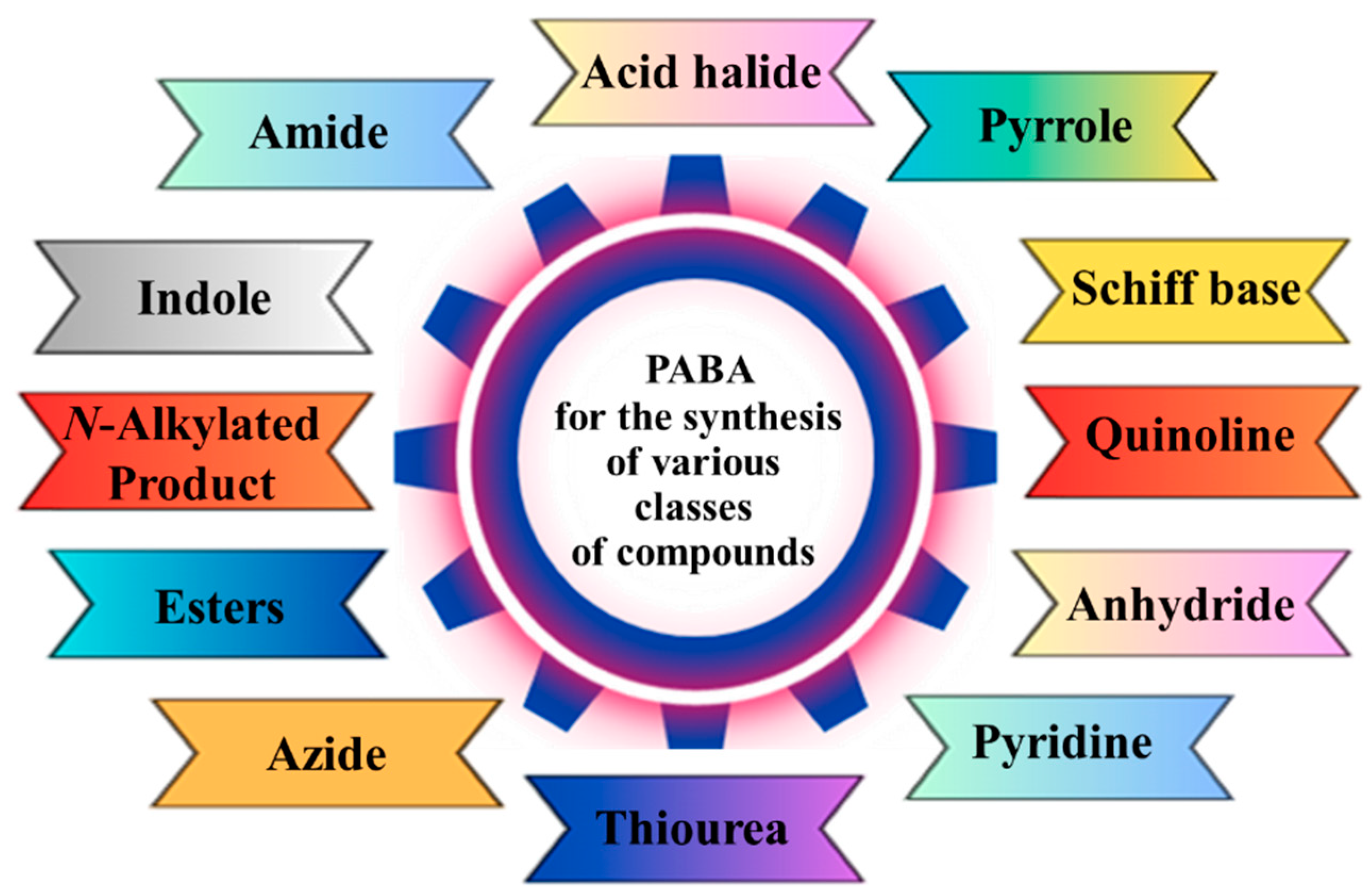


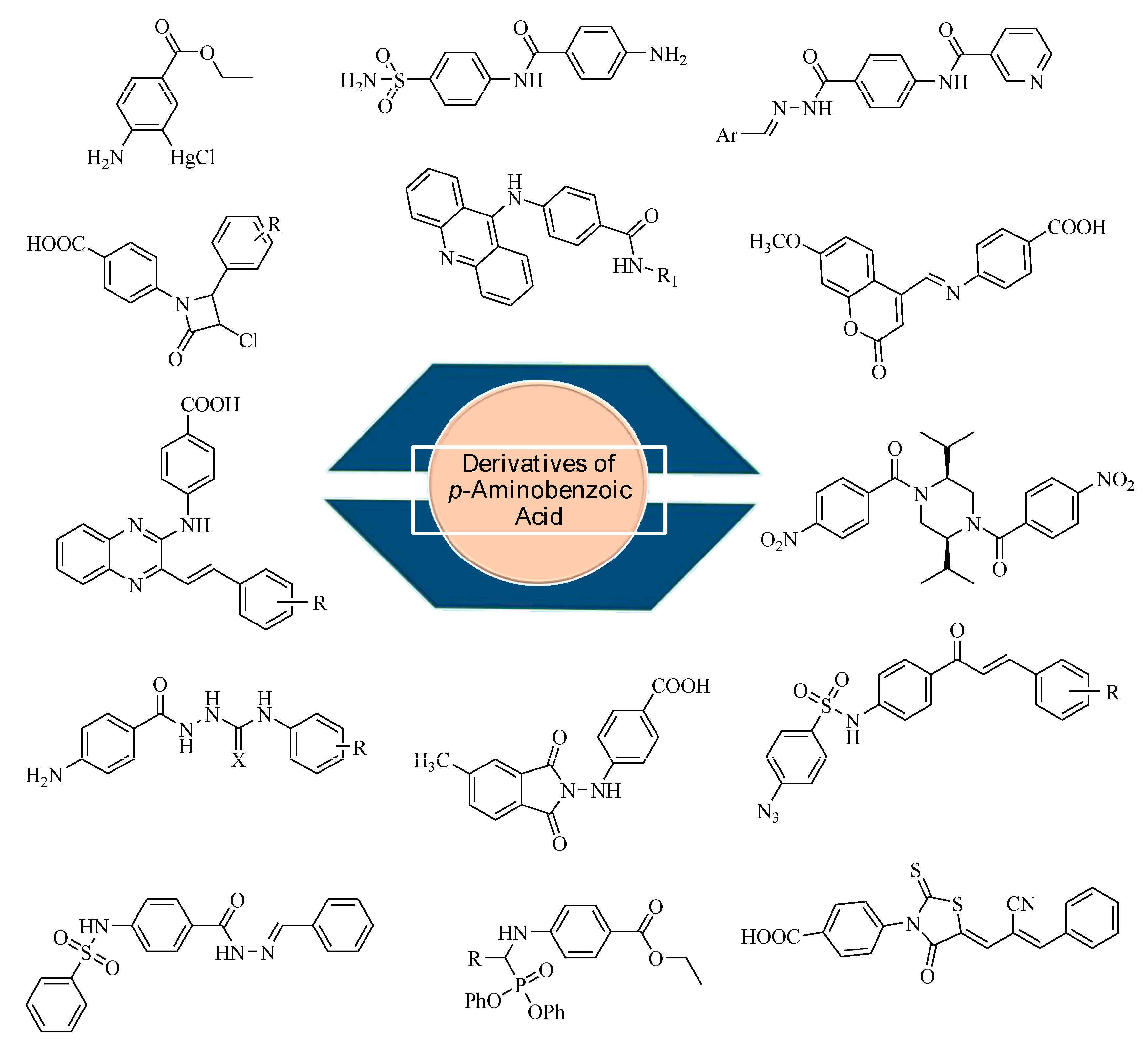
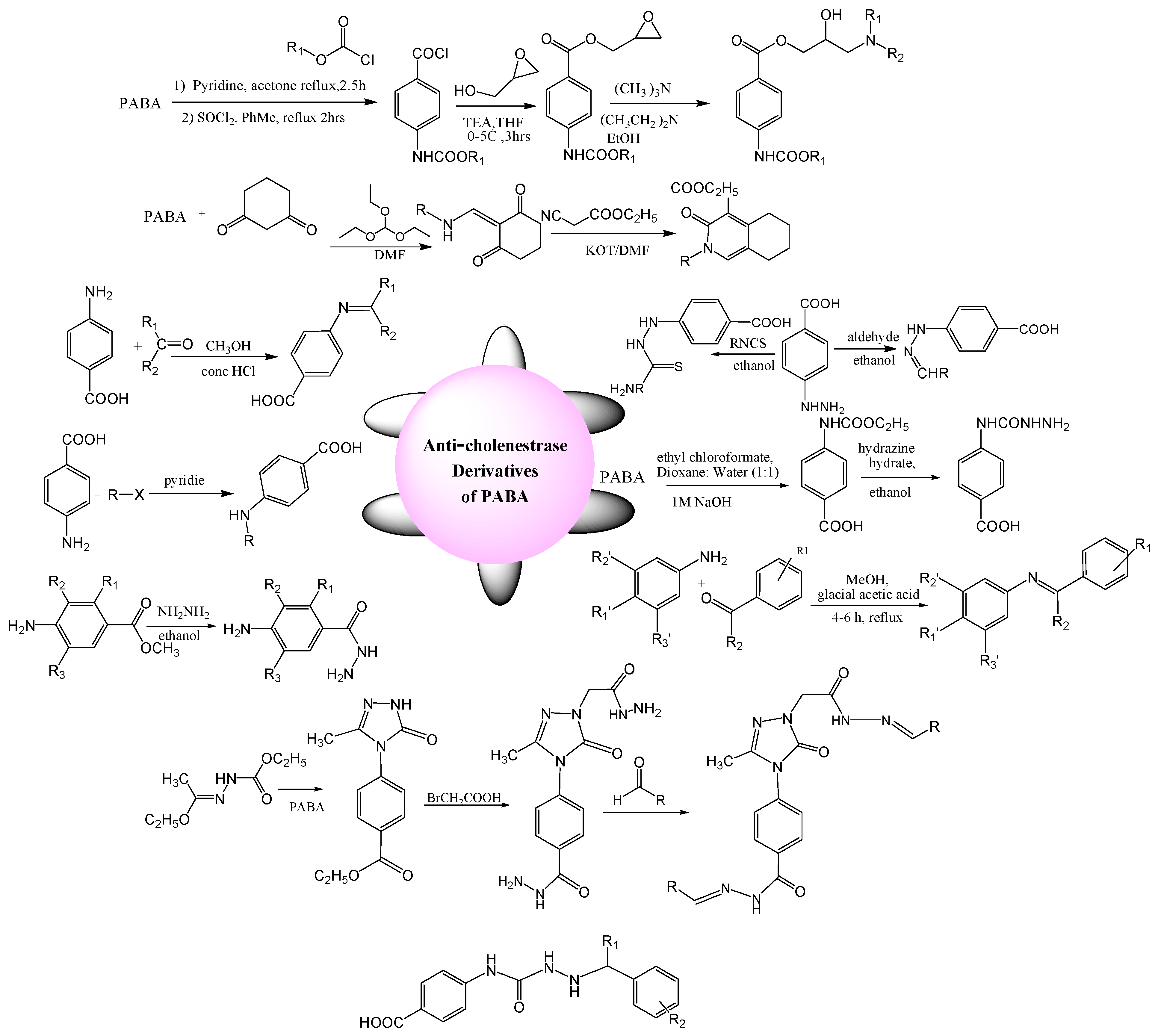
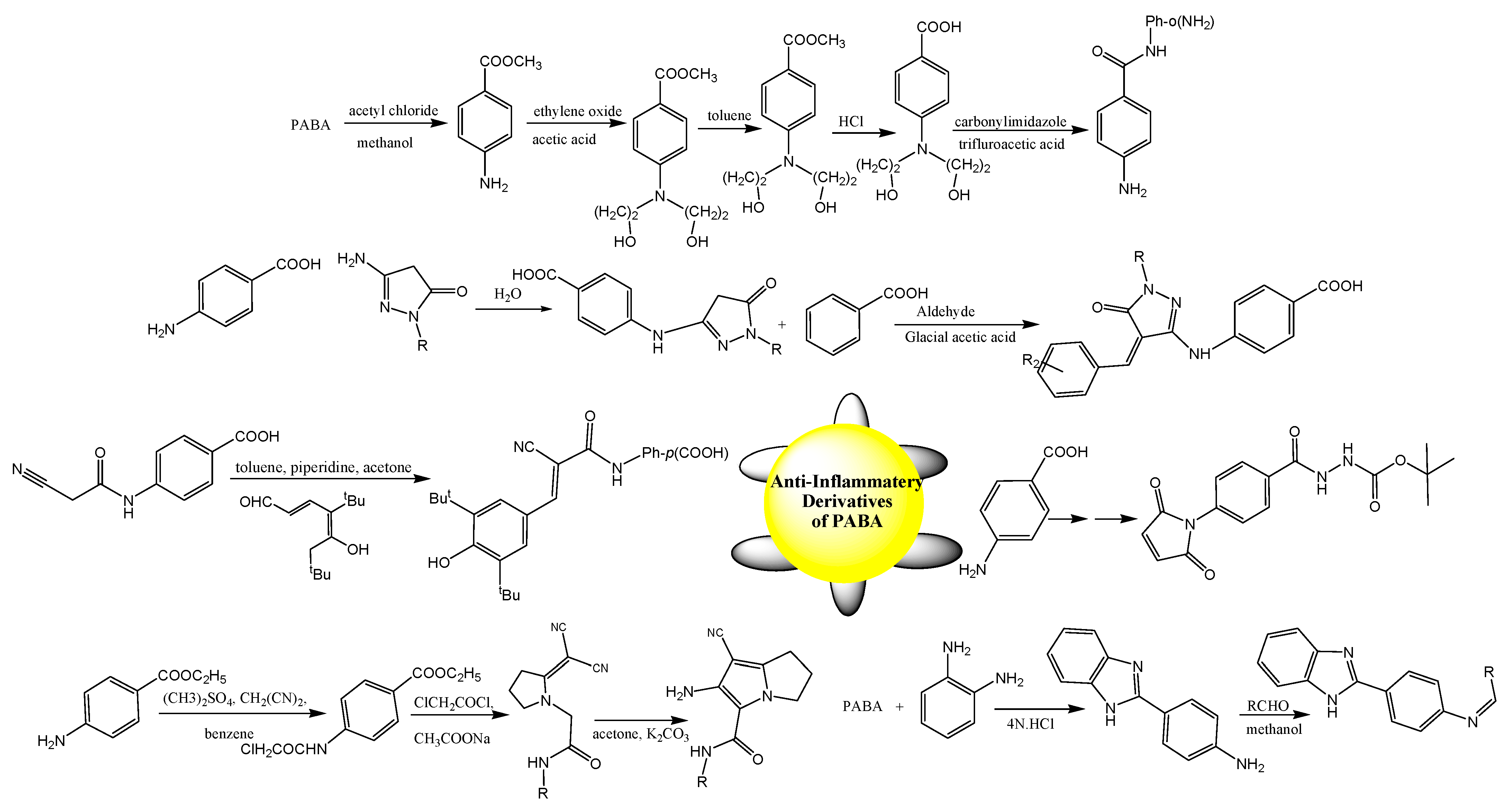

| Derivatives of PABA | Synthetic Conditions | Characterization Techniques | Physical Properties | Biological Activity | IC50 (µM) | Reference |
|---|---|---|---|---|---|---|
| Nonyl 4-nonylamino)benzoate | PABA, alkylating agent, K2CO3, acetone, 5–6 h | EIMS, FTIR, 1H-NMR, and 13C NMR | Amorphous white solid | Cytotoxicity activity against the NCI-H460 cell line | NCI-H460: 15.59 | [112] |
| 4-((5,6,7,8-tetrahydrobenzo [4,5]thieno [2,3-d]pyrimidin-4-yl)amino)benzoic acid | 4-chloro-6,7,8,9-tetrahydro-5H-indeno [2,1-d]pyrimidine, PABA, ethanol, reflux, 4 h | EIMS, FTIR, 1H NMR, and 13C NMR | Yellow crystal, Yield: 88%, m.p: 280–282 °C | Cell lines: EGFRT790M and HER2 kinases and 4 cancer cell lines of HCT-116, HepG2, A431, and MCF-7 | HepG2: 67.72 ± 3.70 HCT-116: 62.57 ± 3.30 MCF-7: 75.75 ± 3.40 | [113] |
| N-(tert-butyl)-4-(2-(3-methyl-2-oxoquinoxalin-1(2H)-yl)acetamido)benzamide | N-(tert-butyl)-4-(2-chloroacetamido) benzamide, potassium salt of 3-methylquinoxalin-2(1H)-one, DMF, KI, heating 3 h | 1H NMR, 13C NMR, and FTIR | Dark green crystal, Yield: 80%, m.p: 230–232 °C | Cytotoxicity against HepG2 and MCF-7 cell lines | MCF-7: 7.7, HepG2: 4.5 | [114] |
| 2-(4-((2-Oxoindolin-3-ylidene)amino)benzoyl)-N-phenylhydrazinecarbothioamide | 4-((5-Substituted-2-oxoindolin-3-ylidene)amino)benzohydrazide, Isothiocyanatobenzene, EtOH, Reflux, 8 h. | EIMS, FTIR, 1H NMR, and 13C NMR | Yellow powder, Yield: 93%, m.p: 211–213 °C | Cytotoxic activity against HepG2 cell line, MCF-7 cell line, VEGFR-2 kinase inhibitory assay | MCF-7: 0.74–4.62 HepG2: 1.13–8.81 VEGFR-2: 0.078 | [19] |
| ((E)-N-(3-(1-(2-(4-(2,2,2-Trifluoroacetamido)benzoyl)hydrazono)ethyl)phenyl)nicotinamide) | 2,2,2-Trifluoro-N-(4-(hydrazinecarbonyl)phenyl)acetamide, N-(3-acetylphenyl)nicotinamide, 6 h and absolute ethanol | EIMS, FTIR, 1H NMR, and 13C NMR | Off-white crystals Yield: 80%, m.p: 246–248 °C | Cytotoxic properties against VEGFR-2, MCF-7 cell lines, and HepG2 | VEGFR-2: 65 nM HepG2: 21.00, MCF-7: 26.10 | [115] |
| 3α-O-(4-acrylamidebenzoyl)-4β-hydroxy-5,7α,6β(H)-guaia-1(10),11(13)-dien-12,6-olide | 3α,4β-dihydroxy-5,7α,6β(H)-guaia-1(10),11(13)-dien12,6-olide, 4-acrylamidobenzoic acid, DCC, DMAP, CH2Cl2, | 1H NMR, 13C NMR, and HRESIMS | White powder, Yield: 56%, m.p: 120–122 °C | Cytotoxicity against Huh7 and HepG2 cell lines | HepG2: 7.9 ± 0.3 Huh: 78.5 ± 0.2 | [116] |
| Ag-PABA complex | PABA, KOH, AgNO3, 1 h | XRD, mass spectrometry, 1H NMR, 2D NMR, and 13C NMR | White solid | In vitro antibacterial activity | MIC value (µM) S. aureus ATCC 25923: 88.5 B. cereus ATCC 14579: 88.5 E. coli: 44.0 | [117] |
| 4-[1-(1,3-Dihydro-benzoimida-zol-2-ylideneamino)-oct-2-ynylideneamino]-benzoic acid | Oct-2-ynoic acid (1,3-dihydrobenzoimidazole-2-ylidene)amide, aniline derivatives, warm ethanoic solution and refluxing for 4 h | UV–Vis absorption, FTIR, 13C NMR, 1H NMR, and C, H, N elemental analysis | White powder, Yield: 73%, m.p. 175.2 °C | Anti-plasmodial activity | Plasmodium Falciparum 3D7: 28.31 µg/mL | [118] |
| Peanut skin extract-azo-compounds and complexes with iron | NaNO2, HCl, ice, peanut skin extract, FeCl2, methanol, 65 °C, reflux 3 h | SEM-EDS analysis, FTIR, and UV-visible spectroscopy | Deep orange, Yield: 56.81%, m.p: > 300 °C | Antimicrobial activity against Staphylococcus aureus and Escherichia coli | Inhibition zone (mm) E. Coli:10.0 ± 0.33 S. aureus: 6.0 ± 1.52 | [119] |
| 4-(1H-Indole-2-carboxamido)benzoic acid | Dry pyridine, CHCl3,1H-Indole-2-carbonyl chloride | NMR, IR spectroscopy, HRMS, and elemental analysis techniques | Yield: 86%, m.p: 256–258 °C | Antifungal and antibacterial activity | Inhibition zone (mm) C. albicans DSMZ 11949: 9–14 | [120] |
| Methyl (S)-2-(4-(4-methylphenylsulfonamido)benzamido)propanoate | Amino acid methyl ester hydrochloride, 4-(4-methylphenylsulfonamido)benzoic acid, DCC, HOBt, DIPEA, THF, | 1H NMR, 13C NMR, and HRMS | Yield: 92%, m.p. 203.1–203.9 °C | In vitro PPRE-activated activity | PPRE-activated activity: 87% | [27] |
| 2-((4-(N-(4-Carboxyphenyl)sulfamoyl)phenyl)carbamoyl)benzoic acid | 2-((4-(N-(4-(Ethoxycarbonyl)phenyl)sulfamoyl)phenyl)carbamoyl)benzoic acid, NaOH, EtOH, 80 °C, 18 h | 13C NMR, 1H NMR, and HRMS (ESI) | White powder, Yield: 82%, m.p. 203–205 °C | Antiviral activity against Nancy, coxsackievirus B3. CVB3 | CVB3: 4.22 Nancy: 4.29 | [121] |
| N,N’-(1,2-phenylene) bis(4-aminobenzamide) and its complexes | ethyl 4-aminobenzoate, 1,2-Benzene diamine, reflux 3 h, MCl2, reflux | UV-Vis, FTIR, 1H NMR, and elemental analyses | Pale green, Yield: 45%, m.p: 230 °C | Antibacterial activity against S. aureus and E. coli | Diameters of antibacterial activity S. aureus: 25 mm E. coli: 28 mm | [122] |
| N-(2-(1-benzylpiperidin-4-yl)ethyl)-4-((3,5-dimethoxybenzyl)amino)benzamide | 4-Amino-N-(2-(1-benzylpiperidin-4-yl)ethyl)benzamide, benzyl halide ACN, 80 °C, 6 h, | 13C NMR, 1H NMR, and HRMS (ESI) | Yellow solid, Yield: 80%, m.p: 118–120 °C | Activity against ChE enzymes | AChE: 0.61, BchE: 2.04 | [123] |
| N-(4-{[(2E)-2-(4-(2,3,4,6-tetra-O-acetyl-β-D-galactopyranoside)-3-metoxybenzylidene)hydrazino]carbonyl}phenyl)benzamide | galactoside, N-(4-(hydrazinecarbonyl)phenyl)benzamide, ethyl alcohol, r.t, HCl, stirring for 24 h | 13C NMR, 1H NMR HRMS (ESI), and FTIR | White crystals, Yield: 84%, m.p: 137–138 °C | Antifungal activity | C. glabrata: 695.2 | [124] |
| 4-(4-(1-(2-Isonicotinoylhydrazono)ethyl)phenylsulfonamido)benzoic acid | Acetylbenzenesulfonamide derivatives, hydrazide derivatives, methanol, 2 h, glacial acetic acid | UV, IR, 1H NMR, 13C NMR, mass spectroscopy, and elemental analysis | White solid, Yield: 41% m.p: 288–290 °C | AChE activity | AChE: 11.12 ± 0.74 | [125] |
| N-(3-(Hydroxycarbamoyl)phenyl)-3,5,6-Trimethylpyrazine-2-Carboxamide | 4-(3,5,6-trimethylpyrazine-2-carboxamido)benzoic acid, NH2OH, | 1H NMR | Yield: 52% m.p: >250 °C | Antiproliferative activities against two HDAC-expressing cancer cell lines: HT-29 and SH-SY5Y | HT-29 cells: 1.96 | [126] |
| Cu(PABA)2(H2O)2 complex | Metal and ligand 1:2 molar ratio (M:L), 30 min, pH value at 5.6, r.t | FTIR and UV-vis spectroscopy | Dark green product | Antimicrobial activity | Inhibition zone (mm) Enterococcus faecalis: 16 S. aureus: 11 | [14] |
| 4-(2-(4-(1H-Benzimidazol-2-yl)phenyl)hydrazono)-1-(4-chlorophenyl)-3-methyl-1H-pyrazol-5(4H)-one | Ethyl 2-(2-(4-(1H-benzimidazol-2-yl)phenyl) hydrazono)-3-oxobutanoate, hydrazine hydrochloride, ethanol, refluxed for 12 h | EIMS, FTIR, 1H NMR, and 13C NMR | Yield: 82%, m.p: 197–200 °C | Antimicrobial activity | MIC (µg/mL) S. aureus: 7.81 S. epidermidis: 1.95 E. coli: 7.81 | [127] |
Disclaimer/Publisher’s Note: The statements, opinions and data contained in all publications are solely those of the individual author(s) and contributor(s) and not of MDPI and/or the editor(s). MDPI and/or the editor(s) disclaim responsibility for any injury to people or property resulting from any ideas, methods, instructions or products referred to in the content. |
© 2023 by the authors. Licensee MDPI, Basel, Switzerland. This article is an open access article distributed under the terms and conditions of the Creative Commons Attribution (CC BY) license (https://creativecommons.org/licenses/by/4.0/).
Share and Cite
Haroon, F.; Farwa, U.; Arif, M.; Raza, M.A.; Sandhu, Z.A.; El Oirdi, M.; Farhan, M.; Alhasawi, M.A.I. Novel Para-Aminobenzoic Acid Analogs and Their Potential Therapeutic Applications. Biomedicines 2023, 11, 2686. https://doi.org/10.3390/biomedicines11102686
Haroon F, Farwa U, Arif M, Raza MA, Sandhu ZA, El Oirdi M, Farhan M, Alhasawi MAI. Novel Para-Aminobenzoic Acid Analogs and Their Potential Therapeutic Applications. Biomedicines. 2023; 11(10):2686. https://doi.org/10.3390/biomedicines11102686
Chicago/Turabian StyleHaroon, Faisal, Umme Farwa, Maimoona Arif, Muhammad Asam Raza, Zeshan Ali Sandhu, Mohamed El Oirdi, Mohd Farhan, and Mohammed Ahmed Ismail Alhasawi. 2023. "Novel Para-Aminobenzoic Acid Analogs and Their Potential Therapeutic Applications" Biomedicines 11, no. 10: 2686. https://doi.org/10.3390/biomedicines11102686
APA StyleHaroon, F., Farwa, U., Arif, M., Raza, M. A., Sandhu, Z. A., El Oirdi, M., Farhan, M., & Alhasawi, M. A. I. (2023). Novel Para-Aminobenzoic Acid Analogs and Their Potential Therapeutic Applications. Biomedicines, 11(10), 2686. https://doi.org/10.3390/biomedicines11102686








